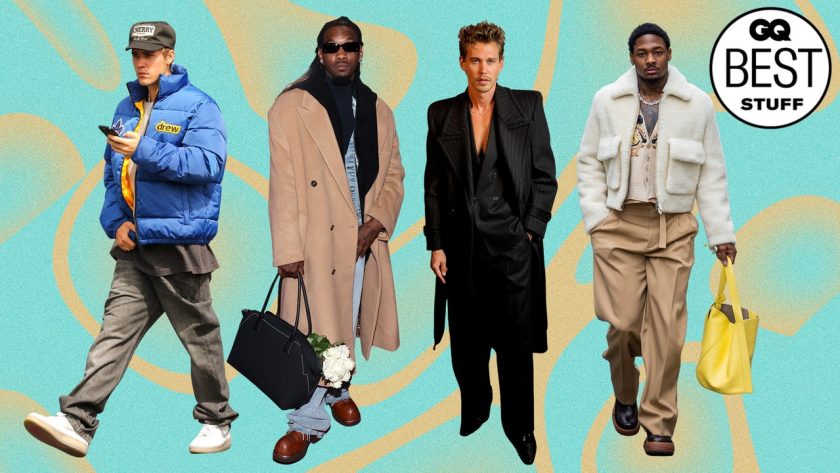Warmth: Winter is, famously, cold. But a super-toasty, 1000-fill-power down jacket may not be the right jacket for you. Winter jackets are often lined with a heat-trapping fabric like brushed flannel, wool, fleece, or corduroy. The warmest winter jackets use some form of insulation, usually either natural duck down or a synthetic fill. Duck down is lighter and warmer by weight; synthetic fills tend to be less expensive and will still preserve heat if they get soaked through.
Waterproofness: Winter is, often, wet. Whether that’s from an onslaught of rain or melting snow, some sort of water-resistance will likely come in handy. Water-resistant jackets usually use some kind of hydrophobic coating—either a synthetic DWR (durable water repellent) coating or some a wax—to prevent water from seeping into your clothes. Both will wear away over time, but can be replenished with off-the-shelf products. More technical jackets will use sealed seams and waterproof-breathable textiles like Gore-Tex, which are great but price-y.
Windproofness: Wind steals the heat your jacket’s trying to trap and preserve. Look for windproof shells of nylon or extremely tightly knit twills.
Breathability: Breathable jackets may sound counterintuitive in a winter context, but trapped sweat turns into heat-sapping moisture if it can’t escape. If you’re going to be active in your winter jacket—whether from hiking or skiing, or just walking a lot—you’ll want to consider prioritizing an outer fabric that lets the hot air escape, like Gore-Tex or Pertex.
Length: A jacket’s length determines how exposed you are to winter’s elements. Most raincoats are longer to protect your torso and legs from getting wet, but many other winter jackets are cut shorter for ease of movement.
Size and Weight: The average wool peacoat will weigh considerably more than a short down puffer. You probably won’t get tired from walking around in any winter jacket, but make sure you’re okay hauling around that thick shearling all day before you splash out on it. Similarly, poofy puffer’s are nice and toasty—but can also be a pain in the ass to stash in a cramped closet or in a small restaurant.
Details: Take into account useful feature: maybe a jacket includes a removable hood or lining that can extend how long you use it into slightly warmer weather. And make sure you’re happy with everything from the hardware—do you want a two-way zipper?—to where the pockets sit to the cleaning instructions. Fancy fabrics are lovely until you spill that Frappuccino and end up with a dry-cleaning bill.
The Puffer Jacket
A great puffer means functionality, sure—it’s the jacket you’ll reach for on the crappiest, bone-chilling-est days of winter. They can be stuffed with real deal goose down filling or synthetic insulation like Primaloft, which puts your bare skin at a good distance away from the biting cold and retains your body heat. Some down jackets are even packable, meaning you can squish them down into a tiny pouch and toss them into your bag when the winter weather feels a bit closer to fall. Technical stuff aside, it doesn’t mean you need to sacrifice your style to wear one. Beyond the sleeping-bag-like coats of your youth, there’s a whole universe of sleek and shapely puffers out there for the coldest of times. Whether you take your cues from A$AP Rocky’s streetwear vibe or George Costanza’s normcore aesthetic is entirely up to you.
The Trench Coat
Given that they were originally designed to keep British army officers warm and dry in the dark, dank trenches of World War I (hence the name), we’re pretty sure these classic coats will be able to handle most anything a wet February day in the city might throw your way. These days, trench coats come in an endless range of cuts and fabrics—single or double-breasted? Belted or not? Water-repellent cotton gabardine or waterproof Gore-Tex?—but the end result is always the same: you’ll look elegant as hell in one, whether it’s tossed on over a suit or a simple tee and jeans.
Firework content
This content can also be viewed on the site it originates from.
The Topcoat
You know that tired chestnut about the Inuit supposedly having 50 words for snow? (Apparently, it’s true.) That’s sort of the deal with topcoats. Call ‘em an overcoat or a great coat, a balmacaan or a chesterfield. The list goes on forever. Each of those distinct styles varies slightly, but they’re bound by a common denominator: they’re long and tailored from a warm, dense fabric—generally wool or cashmere—and will keep you looking and feeling all-business in the face of chilly temps. They’re roomy enough to toss over a hoodie or even a suit, or when the weather is somewhat mild, over a T-shirt and jeans like you’re dashing from gate to gate at LAX.
The Duffle Coat
Beloved by generations of great Brits—from Winston Churchill to Paddington Bear—the duffle coat, with its heavy melton wool body and charming toggle closures, feels more relevant right now than it has in ages. It feels rugged and rustic, but can swing to more refined territory with the right details. Lean into its preppy energy by layering one over a chunky turtleneck and some horsebit loafers, or go full Raf Simons FW11 by wearing one with with your biggest, leather-iest pants.
The Parka
You probably owned a great surplus store parka in high school, and the appeal remains the same: they’re big, they’re tough, they look killer with everything from thrashed jeans and boots to flannel trousers and brogues to cargoes and trail runners. Parkas inherently are designed with hoods. The rest is kind of left up the air. They can be filled with down insulation or they can be left unlined and lightweight enough to pack into a tote bag. They can be zipped up, buttoned up, or pulled over. They can come with a furry hood or a detachable hood. There are many ways to slice it and you couldn’t easily mess it up.
The Peacoat
The peacoat has all the necessary hallmarks of a menswear staple: initially designed for the military (the US Navy, to precise) and once worn (devilishly well) by Steve McQueen. They’re usually made with a dense, super thick Melton wool fabric which is great at keeping the wind out. They’re also usually double breasted and sit just below the butt. Try one with some slim jeans (a little flare is optional, but highly recommended!), beat-up boots, and the collar popped to maximize the ’70s Robert Redford energy.
The Car Coat
No driver’s license necessary. Car coats, known for their long and drape-y silhouettes, are the perfect medium for bringing some texture and flow to your winter ensembles.
The Camel Coat
There’s something instantly elevating about a perfect camel coat. They’ve been around for over a century at this point, but that golden tan tone still stands apart when you step out into a sea of dowdy black and gray overcoats. Though they originated as literal camel’s wool, the style has become more synonymous with the light tan color itself. That’s a great thing because camel wool is pricey stuff, so opting for a camel-colored option in a more conventional wool can save you some serious change without sacrificing the uptown looks. It’s sophisticated, it’s striking, it works with every skin tone. And it’s high time you tried one yourself.
The Raincoat
If you’re smarter than we are and live somewhere with temperate climes all year long, then, first off: Why are you reading this article? And secondly, you can probably get away with a nice light raincoat. Raincoats these days is a pretty broad category. They can be as classic as a trench coat or as rough-and-tumble as a Gore-Tex-laden anorak. They can even be a lightweight outer shell that can get you by when the rain isn’t so intense. That’s good news if, for some reason, you thought that waterproof coats were boxed in to a single style. Here are a few worth considering.
The Flight Jacket
As far as trends go, bomber jackets have tumbled a fair bit from their mid-2010s height. If you ask us, that’s a great thing: these jackets are as authentic and timeless as it gets, and they’re all the more appealing when every third goober at the bar isn’t wearing one. And considering they were originally intended to keep pilots from freezing at high altitudes, the genuine articles pack in a fair bit more heat than they generally get credit for. High-quality jawnz will be outfitted with knit cuffs, premium leather and shearling, and tough hardware. But you’d be surprised with how good some of the more affordable options can be.
The Fleece Jacket
Fleece jackets aren’t blowing up on your Instagram feed just because they’re cute and cozy (for the record, they are cute and cozy). There’s real utility to the fluffy stuff: when Patagonia’s Yvon Chouinard first began making clothing from the fabric in the ‘70s, it was because he was enamored by its combination of durability, lightness, warmth, and washability. (They’re like the Wool Coat 2.0.) And who wants to go through the hassle of taking their wool coat to the cleaners, anyway? You can layer it over a hoodie in the city or under a shell jacket on a snowy trail, and it’ll never steer you wrong. And, yeah, they’re pretty darn cute, too.
The Waxed Jacket
Longtime fans of The Crown, this one’s for you. Waxed cotton hunting jackets, long beloved by British royalty and Brooklyn cool guys alike, are like raw denim jeans for your torso: the longer and harder you wear them, the better they look. And given that they’re hardy enough to keep you safe and sound from the elements and re-waxable ad infinitum, we guarantee you’ll be wearing yours for a very, very long time. They may not be the warmest jackets on the winter coat spectrum, but some options are fleece-lined for extra warmth. Other waxed jacket options can be suped up with attachable linings, upping their versatility for multiple seasons.



